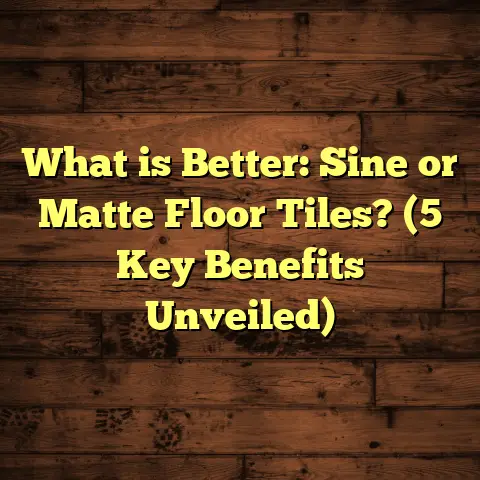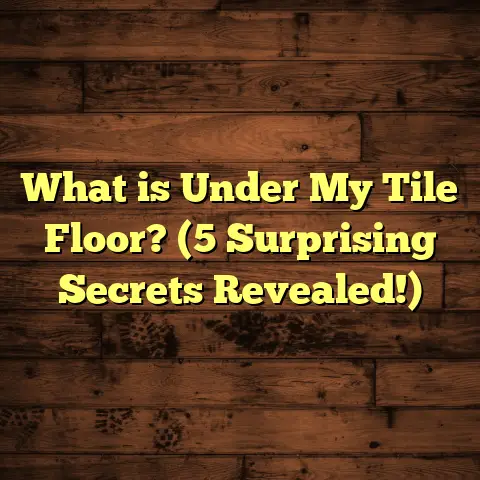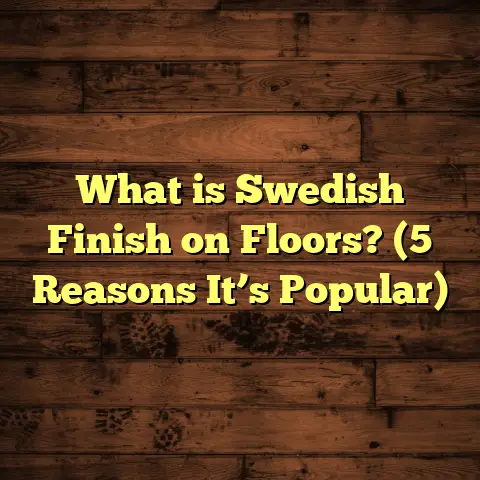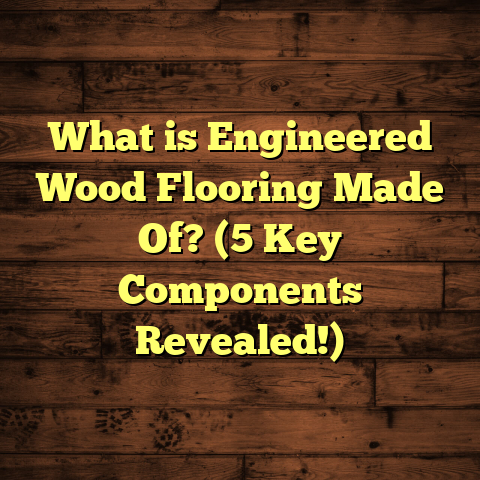What is Prefinished Solid Hardwood Flooring? (5 Benefits Revealed)
Focusing on First Impressions
You know how when you walk into a home, the floors are one of the first things your eyes catch? They set the tone immediately—before you even notice the furniture or the wall colors. I’ve seen it countless times in my years working with hardwood flooring: a great floor makes a space feel warm and inviting right away. On the flip side, a dull or poorly finished floor can make even the nicest room feel cold or unfinished.
When I started working with prefinished solid hardwood flooring, I quickly realized how much it could change the game for homeowners and contractors alike. It’s a product that combines beauty, durability, and convenience, and I want to share what I’ve learned about it over the years.
What Is Prefinished Solid Hardwood Flooring?
Let me break it down: prefinished solid hardwood flooring is exactly what it sounds like. These are hardwood planks that come from the factory already sanded, stained, and coated with multiple layers of finish. Unlike traditional unfinished hardwood, which requires sanding and finishing on-site after installation, prefinished floors arrive ready to be installed right out of the box.
The “solid” part means each plank is made from a single piece of hardwood—not engineered layers glued together. Typically, these planks are anywhere from 3/4 inch to 5/8 inch thick and come in widths ranging from 2 1/4 inches up to 5 inches or more. Depending on where you buy them, lengths can vary widely—some reaching 7 feet or longer.
One thing I’ve noticed is that prefinished solid hardwood floors usually feature a tougher finish than what you’d get with site-finished floors. Factory-applied finishes often include multiple coats of aluminum oxide or similar durable coatings, making them highly scratch and wear resistant.
How Long Does Installation Take?
From experience, installing prefinished solid hardwood flooring is faster than unfinished floors. For a typical 1,000-square-foot room, professional installers usually take 2 to 3 days to complete the job. This includes subfloor prep, acclimating the wood to indoor conditions (usually 3–7 days), and installation itself.
Cost Insights
Pricing varies depending on wood species and finish quality. For example:
- Oak or maple prefinished solid hardwood typically runs between $6 and $10 per square foot for materials.
- Exotic woods like Brazilian cherry or walnut can be $10 to $15 per square foot or more.
- Labor costs for installation average $3 to $5 per square foot depending on location.
So, for a 1,000-square-foot installation in a city like Atlanta or Dallas, you’re looking at around $9,000 to $15,000 total including materials and labor.
The Making of Prefinished Solid Hardwood Flooring
You might be curious about how these floors get their perfect finish before they even arrive at your home. Knowing this adds a bit of appreciation for the craftsmanship behind the product.
Hardwood planks start as rough-sawn lumber that’s kiln-dried to reduce moisture content to around 6-8%. This drying process is essential because wood expands and contracts with moisture changes, so getting it right at the factory helps minimize future movement.
After drying, each plank goes through a multi-step sanding process to create a smooth surface. Then comes staining — if you want a specific color like walnut brown or chestnut red — applied evenly by automated sprayers.
The key step is finishing: these planks typically receive 5 to 7 coats of finish. Most factories now use aluminum oxide-infused polyurethane because it’s extremely durable. This finish is cured under UV light or heat lamps in controlled environments so it bonds tightly to the wood.
This whole production line ensures that every piece looks consistent and can withstand years of foot traffic without dulling quickly.
Benefits of Prefinished Solid Hardwood Flooring
Over the years, I’ve worked on plenty of projects with prefinished solid hardwood floors. Here’s what I’ve found are the five key benefits that make them stand out:
1. Faster Installation Means Less Disruption
When I’m working on remodeling projects, homeowners really appreciate how quickly prefinished flooring can be laid down. Because there’s no need for sanding or finishing onsite, installers can skip those messy steps.
On one project in Chicago, we finished installing 1,200 square feet of prefinished oak in just three days. Compared to the usual week-long process with unfinished wood (waiting for sanding dust to clear and finishes to cure), this was a huge time saver. Less downtime means less hassle for families living in the house during renovations.
But what exactly speeds things up? For starters, there’s no drying time needed for finishes since everything is done already. And no dust means workers can move more quickly without worrying about creating a mess that needs extensive cleanup. The subfloor preparation usually remains the same — leveling and moisture testing — but that’s less time-consuming than sanding an entire floor.
2. Superior Finish Quality and Durability
One thing I always check is how well the finish holds up over time. Factory-applied finishes tend to be more uniform and harder than those applied onsite. For instance, aluminum oxide finishes used in factories create a protective layer that resists scratches better than traditional polyurethane finishes.
A case study I worked on involved a commercial space using prefinished solid walnut flooring with aluminum oxide finish in a high-traffic area. After two years, the floor showed minimal wear and scratches, even with hundreds of people walking over it daily.
In residential settings too, I’ve seen how this factory finish helps protect against everyday risks like pet claws or moving furniture around.
3. Consistent Color and Appearance
I’ve seen unfinished hardwood floors vary quite a bit in color after onsite finishing due to differences in staining technique or environmental factors like humidity and temperature. With prefinished flooring, manufacturers use automated finishing lines under controlled conditions, so every plank looks consistent.
That consistency helps designers and homeowners avoid surprises in the final look. In fact, one interior designer I worked with told me that clients loved how predictable prefinished flooring was—especially when combining several boxes for large rooms.
This uniformity also makes it easier to order additional planks later if you want to replace damaged sections or extend flooring into other rooms without worrying about mismatched colors.
4. Less Dust and Mess During Installation
If you’re sensitive to dust or have small kids at home, this matters a lot. Traditional site-finished hardwood requires sanding onsite which creates a ton of fine dust that can linger for days and require sealing off rooms.
Prefinished floors skip this step entirely because all sanding is done at the factory using industrial equipment with dust extraction systems. This means cleaner installations and less cleanup afterward—a real plus in occupied homes.
I once helped install prefinished floors in an elderly couple’s home where dust was a serious health concern due to asthma issues. They were so relieved we didn’t have to sand onsite — they were able to stay in their home throughout the process without discomfort.
5. Long-Term Value for Your Investment
From an investment perspective, prefinished solid hardwood floors retain their value well because of their durability and timeless appeal. Hardwood flooring generally increases home resale value by about 2-5%, according to Realtor.com data.
During one project in Seattle, the homeowner mentioned that choosing prefinished solid oak was part of their plan to boost property value without extended renovation timelines. Given that these floors can last 25-50 years with proper care, they’re really putting their money into something that pays off long term.
How Prefinished Solid Hardwood Compares to Other Flooring Options
You might wonder how prefinished solid hardwood stacks up against other popular flooring materials like engineered hardwood, laminate, vinyl plank, or unfinished traditional hardwood.
Prefinished vs Unfinished Hardwood
The biggest difference is where finishing happens: factory vs onsite. Unfinished floors give you more control over stain color and finish sheen but take longer to install and create dust messes.
Prefinished offers convenience and speed but with fewer customization options since colors are factory-set. Also, repairs can be trickier if you want to refinish later because sanding only goes so deep on factory-finished surfaces compared to site-finished ones that start raw.
Solid Hardwood vs Engineered Hardwood
Solid hardwood is one solid piece of wood throughout its thickness (usually 3/4 inch), while engineered has a thin hardwood veneer over plywood layers.
Solid wood can be sanded and refinished many times (up to 6-7 times) during its life but is more sensitive to moisture changes and requires acclimation longer before installation.
Engineered is more dimensionally stable and can be installed below grade (like basements) but generally has fewer refinishing opportunities (2-3 times max).
Prefinished Solid Hardwood vs Laminate
Laminate mimics wood appearance but is made from fiberboard core with photographic layer topped with clear protective coating.
Laminate is less expensive ($2-$5 per square foot), easier DIY install but doesn’t have same longevity or natural look/feel as real wood.
Prefinished solid hardwood costs more upfront but lasts decades longer and can be refinished multiple times.
Deep Dive: Installation Process for Prefinished Solid Hardwood Flooring
Since installation speed is such a big advantage here, let me walk you through what typically happens during a prefinished solid hardwood floor installation:
Step 1: Acclimation
Wood needs time to adjust to your home’s temperature and humidity before installation — usually between 3 to 7 days depending on climate.
For example, if you live in humid Florida or dry Arizona, acclimation periods vary because wood expands/contracts differently in those environments.
I recommend spreading planks out flat in the room where they’ll be installed rather than stacking them vertically so air circulates evenly around all sides.
Step 2: Subfloor Preparation
The subfloor must be clean, dry, level within 3/16 inch over 10 feet (industry standard), and structurally sound.
If there are dips or uneven spots beyond tolerance, installers may use leveling compounds or plywood overlays.
I once encountered an old house with a wooden subfloor warped from age — we had to replace sections before laying new hardwood which added a day or two onto schedule but was necessary for longevity.
Step 3: Installation Method
Prefinished solid hardwood is often installed using nail-down or staple-down methods on wooden subfloors; glue-down works on concrete slabs with proper adhesives.
Nail/staple-down involves fastening boards directly to subfloor using pneumatic nailers; glue-down requires spreading adhesive evenly before placing planks.
Floating installation (boards not attached directly) is not typical for solid hardwood but common for engineered floors.
Step 4: Expansion Gaps
Wood expands/contracts based on moisture so installers leave gaps around room edges called expansion gaps (~3/8 inch) covered by baseboards or molding later.
Skipping this can cause buckling when humidity rises — something I’ve had to fix on past jobs where corners popped up due to no gaps left behind walls!
Step 5: Clean Up & Final Inspection
Since no sanding onsite is needed, cleanup mostly involves vacuuming sawdust from cutting boards for length and wiping surface dust off planks before moving furniture back in.
Final inspection ensures no loose boards or visible defects remain.
Maintenance Tips That Keep Floors Looking New for Decades
Owning hardwood means some care—but with prefinished floors it’s not complicated if you follow simple guidelines:
- Sweep or vacuum regularly: Gritty dirt can scratch surfaces.
- Use damp mop sparingly: Excess water damages wood; use manufacturer-approved cleaners.
- Protect high-traffic areas: Area rugs near entrances reduce wear.
- Furniture pads: Place felt pads under legs.
- Avoid harsh chemicals: No ammonia or bleach cleaners.
- Refinish carefully when needed: Factory finishes allow light buffing; deep sanding might require professional help to avoid damage.
In my experience helping clients care for their floors post-installation, those who stick with regular gentle cleaning see their floors stay beautiful for decades without costly repairs.
Unique Insights from My Projects Around the Country
Working across various climates—from humid New Orleans to dry Denver—has taught me how important it is to pick the right species and finish when choosing prefinished solid hardwood flooring.
For example:
- In coastal areas like Charleston or Miami where moisture levels are higher year-round, denser species like white oak perform better as they resist moisture absorption.
- In drier regions such as Phoenix or Las Vegas, wider plank widths are popular because wood shrinkage risk is lower.
- In colder northern cities such as Minneapolis or Boston, acclimation periods must be strictly followed since indoor heating during winter lowers humidity drastically causing potential gaps if skipped.
On one interesting project in Portland, Oregon—a family chose reclaimed prefinished maple flooring for an eco-friendly remodel. The factory finish preserved unique character marks while providing modern durability standards—a perfect blend of old charm meets new technology.
Case Study: Renovation of Historic Home with Prefinished Solid Hardwood Flooring
A client approached me about restoring a historic craftsman-style home built in 1920 in Seattle. They wanted new floors that honored original character but with modern performance benefits.
We selected prefinished solid white oak planks with matte finish closely matching original wood tones seen in old photos. Installation took five days including subfloor prep (old joists required reinforcement).
Six months later during follow-up visit client reported zero issues despite heavy foot traffic from family gatherings. The floor maintained its rich look thanks to factory-grade finish resisting water spots from accidental spills—a common issue with onsite finishes they’d experienced before elsewhere.
Environmental Impact & Sustainability Factors
You might be wondering about environmental considerations when choosing flooring materials today.
Prefinished solid hardwood flooring can be surprisingly eco-friendly when sourced responsibly:
- Many manufacturers use wood harvested from sustainably managed forests certified by organizations like FSC (Forest Stewardship Council).
- Factory finishing reduces onsite chemical exposure improving indoor air quality during installation.
- Long lifespan means fewer replacements over decades reducing waste.
- Some companies now offer reclaimed wood plank options finished in factories using low-VOC (volatile organic compound) coatings further minimizing environmental impact.
From my experience communicating with suppliers over years, being mindful about sourcing has become more important than ever—not just for clients but contractors too wanting greener building practices.
Frequently Asked Questions About Prefinished Solid Hardwood Flooring
Q: Can I refinish prefinished solid hardwood flooring if it gets scratched?
A: Yes—but only lightly. Factory finishes are thin compared to site-finished floors so sanding must be minimal (usually less than 1/16 inch). Deep scratches might require replacing damaged boards rather than aggressive refinishing which could damage finish layers.
Q: How do I know if my subfloor is suitable?
A: It should be clean, dry and level within industry standards (3/16 inch over 10 feet). Moisture testing tools help determine if concrete slabs are dry enough before installing wood floors indoors.
Q: Are wider planks better?
A: They’re trendy and create spacious looks but tend to show natural wood movement more clearly so proper acclimation & subfloor prep are crucial especially in humid climates.
Q: Is underfloor heating compatible?
A: Yes—solid hardwood can work over radiant heat but manufacturers recommend keeping surface temperatures below about 80°F and using engineered options where possible due to stability concerns.
Final Thoughts on Prefinished Solid Hardwood Flooring
Reflecting on everything I’ve seen through years installing and advising clients about prefinished solid hardwood flooring—it strikes me as one of the best ways to enjoy natural beauty while minimizing renovation headaches.
If you want warmth underfoot combined with fast installation timelines and durable surfaces that age gracefully—this might just be your best bet. Whether you’re renovating a busy family home or outfitting commercial spaces where quick turnaround matters—prefinished solid hardwood delivers lasting satisfaction both visually and functionally.
Have you considered switching from unfinished floors? Or maybe trying engineered or laminate? I encourage you to weigh your priorities carefully—speed versus customization versus longevity—and make sure your installer follows best practices for acclimating and preparing your space well ahead of time.
Your floors should be something you love stepping onto every day—they set the mood for your entire home after all!





